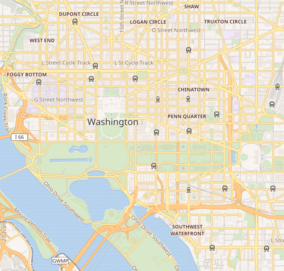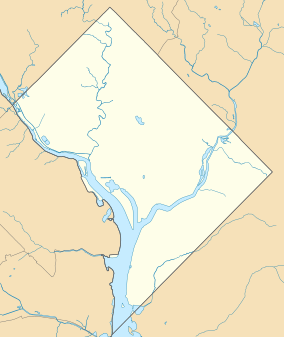Mary McLeod Bethune Council House National Historic Site facts for kids
Quick facts for kids Mary McLeod Bethune Council HouseNational Historic Site |
|
|---|---|

Mary McLeod Bethune Council House
|
|
| Location | 1318 Vermont Avenue, NW Washington D.C., United States |
| Area | 0.07 acres (283 m²) |
| Established | October 15, 1982 |
| Visitors | 8,570 (in 2005) |
| Governing body | National Park Service |
| Website | Mary McLeod Bethune Council House National Historic Site |
The Mary McLeod Bethune Council House National Historic Site is a special place in Washington, D.C.. It protects the home of Mary McLeod Bethune, a very important leader in American history. The house is located at 1318 Vermont Avenue NW.
Visitors can take tours led by National Park Service rangers. There is also a video about Bethune's amazing life. This historic house is part of the Logan Circle Historic District. You can easily reach it by using the Washington Metro public transport system.
Contents
Exploring the Historic House
The site includes two main buildings. There is a three-story Victorian style townhouse. There is also a two-story carriage house.
What Was in the Carriage House?
The carriage house once held the National Archives for Black Women's History. This was a place where important historical records about Black women were kept. In 2014, these records were moved to a different location. Today, the archives and a research center at the property are open by appointment only.
Mary McLeod Bethune's Home Life
Mary McLeod Bethune lived in this townhouse from 1943 to 1955. She bought the house for $15,500. She lived on the third floor of the house. The first and second floors were used by the National Council of Negro Women (NCNW). Mary McLeod Bethune founded this important organization.
The house looks much like it did when Bethune lived there. Most of the furniture is original. It belonged to Bethune and the NCNW.
Becoming a National Historic Site
After Mary McLeod Bethune passed away, the National Council of Negro Women took ownership of the house. They continued to use it as their main office.
Recognizing the House's Importance
In 1975, the local government added the house to the D.C. Register of Historic Places. This meant it was recognized as an important historical building. The NCNW then began a big project to restore the house and its grounds. They wanted to turn it into a museum and a place for research.
An expert named Bettye Collier-Thomas was hired to manage the house. She helped make the museum famous across the country. After a lot of restoration work, the house opened to the public as a museum in 1981.
Federal Protection and Ownership
In 1982, the United States Congress passed a law. This law required the government to work with the NCNW. The goal was to further restore the house and create a museum and archives there. The NCNW kept ownership of the house at first. However, they worked closely with the National Park Service.
More federal money was spent to fix up and preserve the house. By 1987, the government was helping to pay for the house and museum's upkeep. Other money came from companies, charities, and private people.
In 1994, the National Park Service bought the Council House. They officially renamed it the Mary McLeod Bethune Council House National Historic Site. The National Council of Negro Women then moved to a new, larger headquarters. The Council House officially became part of the National Park Service in October 1996.




